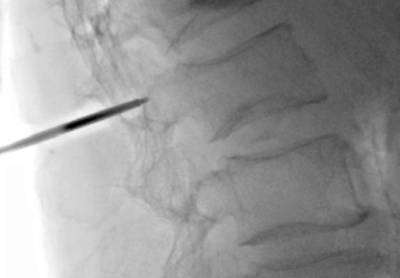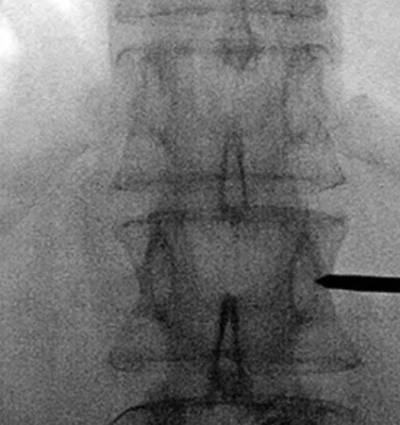Jamshidi needle
The Jamshidi needle is a trephine needle for performing bone marrow biopsy, whereby a cylindrical sample of tissue, a core biopsy specimen, is obtained. It is a cylindrical needle with a tapered cutting tip.
The tapered end reduces the potential of crush artifact.
It is the most commonly used needle for performing bone marrow biopsies.
The device is named for its inventor Khosrow Jamshidi who is an Iranian physician.
see Instruments
Placement
It is placed so that the tip is just short of entering the pedicle on the lateral fluoro.
In the AP view the needle tip should be at or just barely lateral to the lateral edge of the pedicle near the equator of the pedicle at 3 or 9 position depending on the side.
A total of 60 human cadaveric lumbar pedicles were studied. Three different screw insertion techniques were compared: (A) Jamshidi needle and Kirschner wire without tapping; (B) Jamshidi needle and Kirschner wire with tapping; and (C) sharp-tipped screw insertion. Pullout tests were performed at a displacement rate of 10 mm/min recorded at 20 Hz. Mean values of these parameters were compared using paired t-tests (left vs right in the same specimen): A vs B, A vs C, and B vs C. Additionally, 3 L1-L5 spine models were used for timing each screw insertion technique for a total of 10 screw insertions for each technique. Insertion times were compared using a 1-way analysis of variance.
Results: The mean pullout force for insertion technique A was 1462.3 (597.5) N; for technique B, it was 1693.5 (805.0) N; and for technique C, it was 1319.0 (735.7) N. There was no statistically significant difference in pullout force between techniques (P > 0.08). The average insertion time for condition C was significantly less than that for conditions A and B (P < 0.001).
Conclusions: The pullout force of the novel sharp-tipped screw placement technique is equivalent to that of traditional techniques. The sharp-tipped screw placement technique appears biomechanically viable and has the advantage of saving time during insertion.
Clinical relevance: Single-step screw placement using high-resolution 3-dimensional navigation has the potential to streamline workflow and reduce operative time 1).
The aim of a study was to compare the accuracy, safety, and usefulness of percutaneous pedicle screw placement for lumbar fixation using a multi-axis angiography unit (MAU) and an electronic conductivity device (ECD) with a cannulated Jamshidi needle with that using a conventional C-arm. Of 65 cases that underwent lumbar fixation (region between L1-S1) during April 2013 to March 2019, 57 cases that could be followed up for more than 12 months after the procedure were included. Among them, 31 patients (150 screws) received treatment with MAU and ECD (MAU+ECD group), and 26 (117 screws) were treated with the conventional C-arm. We performed a retrospective study of the surgical techniques used in each group at our institute by assessing the accuracy of PPS using Gertzbin-Robbins classification and the Japanese Orthopedic Association (JOA) score for recovery. There was no significant difference in surgery outcome based on the JOA recovery rate. There was a significant difference between the two groups in terms of Accuracy-1 (Group A indicating accuracy and Groups B-E indicating inaccuracy), where the rates were 85.3% and 72.0% in the MAU+ECD group and C-arm group, respectively (P = 0.008). There was also a significant difference between the two groups in terms of Accuracy-2 (Groups A-B indicating accuracy; Groups C-E indicate inaccuracy), where the rates were 98.0% and 92.4% in the MAU+ECD and C-arm groups, respectively (P = 0.036). A combination of MAU and ECD is a safe and accurate method for inserting screws into the pedicle 2).

